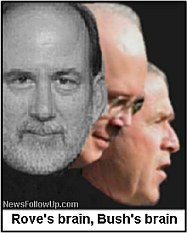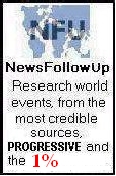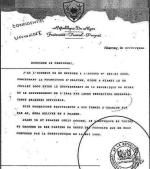Clayton
Hallmark, jeudi, 28/07/2005 - 14:34 Analyses | Lois sécuritaires-
Karl Rove's foreign-policy advisor, Michael Ledeen, proclaimed
"the rightness of the fascist cause" in 1972. In 1984 he got
George Bush Sr to appoint Iranian arms merchant and Iranian/Israeli
double-agent Manucher Ghorbanifar as a middleman in the scandalous
Iran-Contra affair. Ledeen has been a fixture in Washington and Israel
ever since, advocating a modern version of the Crusades against Islamic
nations. Based on what he has said and written, I believe Ledeen is
insane.
Michael Ledeen, Rove's "brain," is one of the leading
advocates for a US attack on Iran. The Washington Post quoted Ledeen as
saying that Rove told him, "Anytime you have a good idea, tell
me." I guess that means we can look forward to the Bush team drumming
up a war with Iran. [For more, see articles by Dan Froomkin of the
Washington Post -- the main man of the mainstream media pursuing the Rove
Scandal.]
George Bush Jr., when he assumed the presidency in 2000, already knew
that he was going to settle the family score with Saddam Hussein. His
"brain," Rove, quickly enlisted Ledeen to trump up a causus
belli.
EARLY 2000: ROCCO MARTINO AND THE FRENCH CONNECTION
Rocco Martino is a 66-year-old Italian gentleman SEE PHOTO who worked
on and off for the Italian SISMI (analogous to the CIA) for many years and
who also peddled the same information to various spy organizations and
publications -- a convicted felon and international stool pigeon, just the
kind of person Ledeen's associates needed.
After being fired by SISMI (for receiving stolen checks, among other
things), he convinced the French intelligence in 2000 that he knew all
about Africa and the trafficking of conventional and nonconventional arms.
To avoid stepping on the toes of Italian intelligence, the French gave him
a contact, or handler, in Brussels. Martino's handler in Brussels asked
him to obtain every type of news or reference to contraband uranium from
Niger ("NYE-jer) -- a former French colony in the Sahara desert (not
to be confused with ex-British Nigeria in W. Africa), where mining was
under the jurisdiction of two companies controlled by the gigantic French
mining company Cogema.
#file_1#
Martino soon was knocking at the door of the embassy of Niger in Rome,
where he met an Italian functionary (a "lady," by most reports
-- but this was no lady, as we shall see). Martino provided the French
with documents showing that Iraq may have been planning to expand trade
with Niger. In fact, the first set of documents did not refer to uranium,
and the trade plans were probably the typical sort of relationship Arab
oil states had with a whole range of third-world countries.
Martino was surprised when he saw that the French immediately jumped to
the wrong conclusion and thought that the documents indicated an Iraqi
interest in uranium. (We now know that Iraq had no nuclear program.)
"We need additional confirmation and more detailed information,"
said the French secret service. Martino set out to satisfy his French
patrons with additional documents.
JANUARY 2001 BREAK-IN AT NIGER EMBASSY
At night, between the first and second of the January 2001, a
mysterious thief came to the embassy of Niger in Rome and into the
residence of the counselor in charge. It turned out that some letterhead
and seals (see photocopy) were missing. A second dossier on Niger-Iraq
trade soon came into Martino's hands, one that included references to
uranium trafficking. Martino claims he got it from embassy personnel and
that he thought it was authentic.
Martino passed it on to the French secret service, who had paid for it,
and also to Panorama [a magazine owned by Bush ally and Italian president
Silvio Berlusconi], which assessed it by dispatching a female reporter to
Niger. Panorama also turned the file over to the US Embassy in Rome for
cross-checking in the US.
The female journalist soon told Martino that the trip to Niger had not
produced any real confirmation, and also the French confirmed to Martino
that the reports he had passed on to them were groundless. In other words,
Bush's war rationale was debunked way back in 2001 by amateur and
professional sleuths.
Furthermore, it was a very amateurish forgery, not likely produced
through official channels by any state intelligence agency with their vast
resources. However, it was soon resuscitated as the Bush administration,
in its first year, ramped up its public relations campaign for war.
ROME MEETING IN DECEMBER 2001
Michael Ledeen organized a meeting in Rome to gather evidence to
support the planned war. Present were:
1. Michael Ledeen, Karl Rove's foreign policy advisor and organizer of
the meeting
2. Nicolo Pollari, head of the the Italian equivalent of the CIA, the
SISMI
3. Italy's Minister of Defense, Antonio Martino (no relation apparently
to the spy Rocco Martino), Pollari's boss
4. Larry Franklin, an American who presently is being prosecuted in the
US for giving classified information to an Israeli front group, AIPC
(American Israel Public Affairs Committee) -- which some would call
"spying," even though he has not been charged with espionage
5. Harold Rhode: member of Dick Cheney's Office of Special Plans,
protege of Ledeen, go-between with Iraqi exile and CIA asset (at the time)
Ahmed Chalabi.
Ledeen already had a longstanding friendship with Francesco Pazienza,
an Italian felon and forger who had been kicked out of the official
Italian intelligence organization SISMI but who had found a new home in
the renegade intelligence agency P-2 (Propaganda Due). Pazienza apparently
was not present but definitely was known to Italian intelligence agents,
including Rocco Martino, as well as to Ledeen.
Ledeen also was a personal friend of Pollari, who, like Ledeen, is a
master of the card game bridge (Ledeen writes columns on it). There are
close ties between Pollari's official intelligence organization, SISMI,
and Pazienza's unnofficial one, P-2. In fact, P-2 recruits from SISMI.
This little group dusted off Martino's discredited second dossier on
Iraq-Niger trade, with the uranium references. The Bush administration now
had its causus belli.
CAUSUS BELLI: A PIECE OF CRAP [SEE PHOTOCOPY]
#file_2#
The accompanying figure shows a bit of the cobbled-up intelligence
report on stolen letterheads, forged by amateurs -- most likely Ledeen's
friend, Francesco Panzienza. This document, which can be viewed at the
Israeli site http://www.4law.co.il/Le838k.html, is the
"evidence" on which George Bush sent almost two thousand young
Americans and untold thousands of Iraqi civilians to their deaths.
SPRING 2002: JOE WILSON TO NIGER
Former US Ambassador (to Gabon) Joseph Wilson made the trip, apparently
at the behest of the CIA, to determine the authenticity of the charges in
Martino's documents, even though the CIA already could see they were
forgeries. Even the Panorama reporter could have saved him the trouble.
Wilson reported back to the CIA that there was no proof that Iraq had
sought uranium in Niger. The US government knew there was no proof.
FALL 2002: USING THE CRAP
In London, Tony Blair spoke on September 24, 2002, for the first time
on the attempts of Saddam Hussein to obtain uranium from Africa. Bush soon
began to drive in the nail using the same argument. Remember, Martino had
delivered the phony dossier this was based on to the US embassy in Rome
over a year before. The US State Department and CIA rejected it and even
Panorama had debunked it. The Pentagon, too, knew it was false, of course,
but the Wolfowitz-Feith-Perle Defense Policy Board axis plus Bush and
Cheney and their respective aides, Karl Rove and I. Lewis Libby (both now
subjects of interest to US Attorney Patrick Fitzgerald and his grand jury
in Washington, DC), went with it anyway.
THE REST IS HISTORY: "The British Government has learned that
Saddam Hussein...
...recently sought significant quantities of uranium from Africa."
Sixteen little words in Bush's January 2003 State of the Union message
that will be remembered in history with more honorable presidential words
like, "The only thing we have to fear is fear itself" (FDR).
Bush was going on the forged documents procured by Rocco Martino, debunked
by all pertinent experts, and debunked by Joseph Wilson. The US overcame
Iraqi opposition -- temporarily (resistance became "suicide,"
now wonders, for whom?) -- mainly by bombing civilian structures rather
than fighting, beginning on March 19, 2003
Wilson's outraged response to using, for murder, evidence he had
debunked got his family, or at least his wife, targeted by that amoral
husk of a man, Karl Rove, who, along with I. Lewis (Scooter) Libby
(Cheney's chief aide) outed Valerie Wilson to Robert Novak, Judith Miller
(the jailed New York Times reporter and pro-war hawk), Matthew Cooper
(Time's reporter who has jeopardized Rove in a criminal investigation),
and numerous other journalists. Most, like Miller and Cooper, wisely
resisted Rove's bait.
IMP OF IMPS: MICHAEL LEDEEN'S DAUGHTER SMILES IMPISHLY IN IRAQ [PHOTO]
#file_3# The war is not just about oil, Israel's fears/ambitions, or US
hegemony. There are contracts and contractors in Iraq. Modern-day
carpetbaggers with briefcases descended like a plague of scorpions on the
poor, bloodied, bombed-out, grieving people of Iraq. They included the
daughter of the war's chief banshee -- Simone Ledeen, Michael's young
daughter -- shown in the photo, greeting with an impish smile another
occupier at the Baghdad airport -- getting ready to lord it over the
Iraqis as she tries out her new MBA in working for the CPA. Caption:
"The creatures step out of the tripods." Maybe it'll help to pay
off those student loans -- huh, Michael?
LEDEEN FELLOW-TRAVELER FRANKLIN FACES A COURT TRIAL
At Ledeen's (Rove's brain) meeting with Italian intelligence in
December 2001 was one Larry Franklin.
The FBI caught Franklin, 58 -- a Pentagon analyst on Iran and an Air
Force Reserve colonel -- meeting two agents of AIPAC, Israel's US
"lobby," in an Alexandria, VA, restaurant in June 2003. AIPAC
employees -- including AIPAC agents at the meeting, Steven Rosen and Keith
Weissman -- had been under FBI surveillance for a couple of years. The FBI
was surprised by Franklin showing up and began investigating him, too. The
FBI arrested Franklin, on May 4, 2005, for illegally disclosing highly
classified information to AIPAC -- spying for AIPAC, in other words. He is
free on bond and is expected to plead innocent at his trial.
Why hasn't the FBI arrested anyone at the AIPAC? Who in the Bush
administration is blocking justice in this case? For that matter,
why hasn't the FBI interviewed Rocco Martino, the acknowledged and
admitted procurer of the phony Niger uranium documents? They are known to
be investigating the phony documents.
The United States has had no qualms about getting audacious in Italy by
having the CIA abduct an Egyptian cleric, Abu Omar, off the streets of
Milan in February 2003, for "exceptional rendering," aka
"torture," in Egypt. This open violation of Italian sovereignty
was supervised by the CIA's station chief in Milan, Robert Seldon Lady,
formerly of the New Orleans area.
Lady Is No "lady": ROBERT SELDON LADY. It is my belief
that the "Italian functionary," or "a lady," that
Martino referred to was actually a Lady, Robert Seldon Lady Sr, the same
man who headed up the torture abduction of Abu Omar.
Italian prosecutor Armando Spataro has just obtained arrrest warrants
for 6 more CIA spies in addition to the original 13 that included Robert
Lady, in connection with the abduction.
Robert Seldon Lady, 51, lived in Abita Springs, Lousiana, until 2001,
when he left for the Milan post. He still has an address in New Orleans,
according to Cryptome http://cryptome.org/lady-eyeball.htm. He and his
wife Martha own a villa in the Italian countryside near Penango (Asti) and
Turin, where they hoped to retire before he went on the lam. Born in
Honduras, he was an affable New York City cop in the 80s who infiltrated
leftist groups. He is something of an electronics hacker (at least of cell
phones). And now he is a wanted felon in Europe.
During the operation, Lady apparently worked directly with the
commander of the 31st Security Police Squadron, Lt. Col. Joseph Romano,
USAF, at the Aviano Air Base in Italy. Lt. Col. Romano, who currently
works at the Pentagon, also is sought for interviewing by Italian
prosecutors. At the time, Romano worked under Brig Gen R. Michael Worden,
commander of the 31st Fighter Wing, who also should have to answer some
questions.
The Italian prosecutor could release the photographs of the American
kidnap-torture perps at any time. This case -- Robert Lady's kidnapping of
Abu Omar -- could become a very big story because of its possible effects
on relations between nations.
![]() = go
to NFU page
= go
to NFU page
 Michael Ledeen
Michael Ledeen
![]() = go
to NFU page
= go
to NFU page


